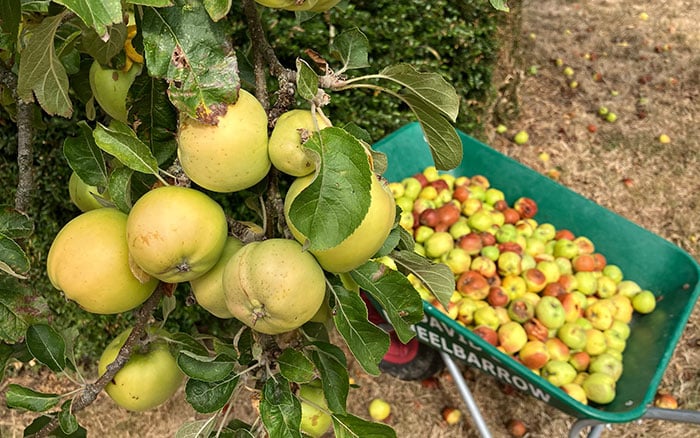There’s no greater sight when you look at your fruit bearing trees to see them laden with fruit. It’s one of the joys of growing fruit in your garden. But natural drop or windy conditions can sometimes lead to a mass of fallen apples, that are rotten or bruised. So, what do you do with a mass of rotting fallen apples?
Windy woes
Now with any bountiful fruit, it’s likely there will be some bruised or rotting produce amongst your windfall. Typically, this is brought about by the wind itself where a gust has plucked the fruit from the branches and dropped it. So, the question remains, what do you do with the fruit that has fallen? Well for this collection of bruised or rotting fruit, I have a few suggestions on what you can do with it.

Composting fallen apples
You could add the fallen fruit to the compost heap as and when they fall. Doing this would supply nitrogen as a ‘green’ material to the mix. However, in late summer or autumn, there may be a larger amount of fruit to incorporate. If this is the case, adding them all to the heap can add too much nitrogen. And therefore slow down the process and lead to a mushy consistency. Something you don’t really want.
So, what I suggest is to create a balance by adding brown materials like straw, cardboard, shredded paper, and fallen brown leaves. This can be added with a layer of apples, then a layer of cardboard and repeated. It’s a tiered compost cake if you like. With this approach it’s ideal to cut the apples and the cardboard into smaller pieces. This will help the materials breakdown more easily and encourage the compost process along.
Unless you are starting your own brewery, don’t let the fruit ferment in my example, apples, ferment or produce an unpleasant aroma. A compost recipe of one-part apples to two-part brown material will reduce the likelihood of this happening. Finally, use the radio of one-part apples to two-part brown material.

Let the birds have them
Fallen fruit can supply a much needed food source for ground feeding birds such as robins, blackbirds and thrushes at a time of year when other sources of food are becoming more scarce and they also contain vitamins and minerals beneficial for bird health.
You may be lucky and attract a flock of fieldfares, seasonal visitors and colourful members of the thrush family. They too are partial to fruit.

Trenching the fruit
There is another method used to rid large gluts of apples, this is what’s known as trenching. This does need quite a bit of space though, so isn’t suited for every garden. This process is exactly what it sounds like, which involves a trench of around 30cm deep being dug to accommodate a depth of around 10-15cm of apples. These can then be covered with the soil that was initially removed to dig the trench.
Though this will create a mound on top of the surface, this will gradually sink as the apples decompose. Bear in mind that this isn’t an instant technique and will have to stay in place for around two years for the fruits to decompose.

Keep an eye out
Whatever you choose to do with the fallen apples, it’s best to not leave them on the ground. They maybe harbour pests or diseases that could spread. Leaving rotting apples on the ground can result in a fungal disease known as brown rot or Monilinia fruitigena. This can then overwinter and lead to an infection in the tree the following season.
The sugar in the fruits is also attractive to wasps, just like fruit juices and cider are. In fact, cider is made from fermented sugars which is why they find fermenting apples so appealing. Whether you’ve got small children in the house, or just want to avoid stepping on a wasp, you’ll want to pick up the fruit as soon as possible.

So, remember pickup your fallen fruits to keep your garden healthy. Pick up rotting fallen apples and dispose of them in your compost bin or by trenching if you have the space.
For more great gardening advice, make sure you head to my YouTube Channel. Make sure you’re subscribed with notifications on so you don’t miss any of my new videos.
Frequently Asked Questions
1 – Why do apples fall early from my tree?
Strong winds and natural fruit drop often cause aunderripe or damaged apples to fall before harvesting.
2 – What’s the best composting ratio for apples?
Try one part apples to two parts brown material for a well-balanced compost mix that breaks down cleanly.
3 – Will fallen apples attract pests in the garden?
They can. However, removing or using them quickly, through composting or trenching, helps prevent unwanted pests.
4 – Where should I place apples for garden birds?
Choose quiet, sheltered areas under shrubs or trees to create safe feeding spots for ground-feeding birds.
5 – What is trenching and how does it help?
Trenching means burying apples in a shallow trench to decompose slowly – ideal for large gluts in spacious gardens.

Leave A Comment